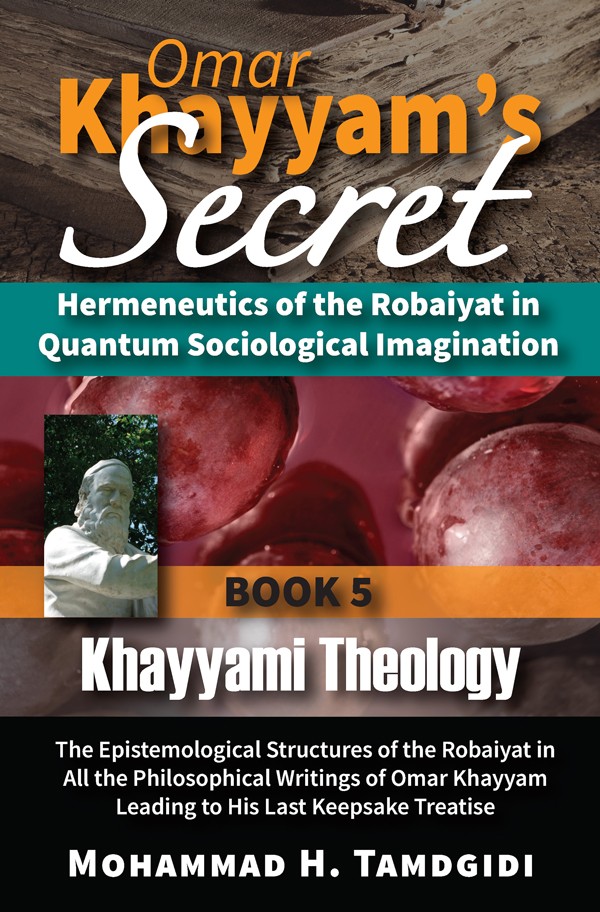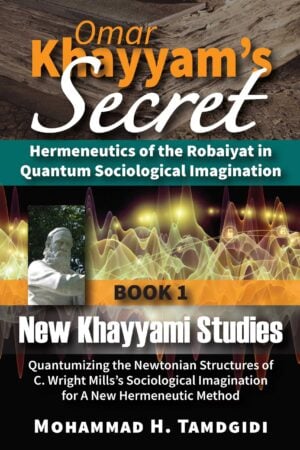Book Section: CHAPTER II — Omar Khayyam’s Treatise on the Created World and Worship Duty: The Arabic Manuscript with Updated Persian and New English Translations, Followed by Textual Analysis — by Mohammad H. Tamdgidi
$20.00
This essay titled “Omar Khayyam’s Treatise on the Created World and Worship Duty: The Arabic Manuscript with Updated Persian and New English Translations, Followed by Textual Analysis” is the second chapter of the book Khayyami Theology: The Epistemological Structures of the Robaiyat in All the Philosophical Writings of Omar Khayyam Leading to His Last Keepsake Treatise, which is the fifth volume of the twelve-book series Omar Khayyam’s Secret: Hermeneutics of the Robaiyat in Quantum Sociological Imagination, authored by Mohammad H. Tamdgidi.
Description
Abstract
This essay titled “Omar Khayyam’s Treatise on the Created World and Worship Duty: The Arabic Manuscript with Updated Persian and New English Translations, Followed by Textual Analysis” is the second chapter of the book Khayyami Theology: The Epistemological Structures of the Robaiyat in All the Philosophical Writings of Omar Khayyam Leading to His Last Keepsake Treatise, which is the fifth volume of the twelve-book series Omar Khayyam’s Secret: Hermeneutics of the Robaiyat in Quantum Sociological Imagination, authored by Mohammad H. Tamdgidi.
In this chapter Tamdgidi offers and then analyzes the original Arabic text, an updated Persian translation, and a new English translation of an important treatise written by Omar Khayyam, titled “Resalat fi al-Kown wa al-Taklif (Treatise on the Created World and Worship Duty),” one that has also been titled variously as a treatise on “Being and Obligation,” “Being and Necessity,” “Existence and Duty,” among others.
The treatise was written in Arabic by Omar Khayyam in the year 473 LH/AD 1080-1081 (as noted in its introduction itself), about a year after Khayyam presented his annotated Persian translation of Avicenna’s Arabic “Splendid Sermon” in Isfahan—which was studied in Chapter I of this volume. Given our discovery in this series (in Book 2) of Khayyam’s true birth date, we can affirm that the treatise “al-Resalat fi al-Kown wa al-Taklif” was written when Khayyam (b. 412 LH/AD 1021) was about 61 lunar, or 59-60 solar, years old.
Abu Nasr Muhammad ibn Abdolrahim al-Nasawi (meaning, from Nasa, a region in Khorasan, where Neyshabour is also located), who was at the time an Imam and judge in the Fars region of today’s Iran (where Shiraz is also located), had sent a letter to Khayyam asking to comment on the topic of the created world and the duty to worship. Khayyam’s response resulted in the writing of this treatise. It is therefore to Nasawi that the treatise is addressed. Khayyam refers to him as a “brother” and reverently, although from the introduction to the treatise (which was apparently written by the original scribe but may include passages from the request letter written by Nasawi himself) it is clear that he regarded Khayyam to be higher in intellectual status than himself.
It would not be entirely accurate to translate the first word of the treatise’s title as just “being” or “existence” since these words are broader terms, ones that include God as well. Of course, God is implied in the notion of a created world, but the point of the treatise is to focus on the created world, its nature, and the place of humankind in it. Khayyam himself makes this distinction very clear and explicit in the treatise, when he says what he means by “al-kown” is the world of possible existence, such that it would be possible to imagine that it could not exist—a condition that does not apply to God, as a Necessary Being.
As for the second term of the title, “al-taklif” generally means “duty,” “obligation,” or “responsibility.” However, again, both Nasawi and Khayyam have the specific, religious, duty in mind here, having to do with the duty to worship, in all its forms, implying generally the duty to remember God as the Creator. So, were we to translate the title’s second word, the notion of “duty” per se would not be specific enough to convey the notion of “duty to worship.” “Duty” is certainly better than just simply using the term “necessity,” however, for the latter is even more abstract and overly broad, not giving a proper sense of what the treatise is about. The word “taklif” in both Arabic and Persian implies a religious connotation for the duty. However, it additionally implies a duty (to worship) that is divine sanctioned. Nasawi’s request and Khayyam’s discussion throughout the text make it clear that the subject of this treatise is the God-sanctioned duty to worship in the context of a created world.
Nasawi was not a supreme judge but a local judge in the Fars region, and nothing in the actual main text of this treatise as existing in the original handwritten manuscript suggests that Nasawi was a pupil of Avicenna. Tamdgidi explains how the error in identifying Nasawi as a pupil of Avicenna came about, based on the misreading of a marginal note by a reader commenting on the passage where Khayyam refers to himself as having been a pupil of Avicenna. Also, Tamdgidi explains how a careful reading of Nasawi’s request letter and lines of poetry directed at Khayyam, while also noting a misreading of another word in the handwritten manuscript, can in fact be regarded as evidence for the acknowledgment by a living contemporary of Khayyam of his having been a respected philosopher poet.
The notion of “succession order” as found to be also central to this treatise of Khayyam (as we know it was in his last keepsake treatise on the universals of existence) is not only central for him in an ontological sense, but can also be useful and meaningful in an epistemological sense. It is in this treatise that Khayyam tentatively introduces the notion as having emerged from the conversations he had had with Avicenna, a notion that became firmly established in his worldview as evident from his last keepsake treatise on the universals of existence.
Khayyam’s engagements with that notion have already given us a sense that his epistemology is deeply informed by an ontology of creation in which human conscious and intentional effort is not simply a secondary and reflective, but an active and primary determining, factor in making humankind human. What exists is not just objective, but also subjective, the reality of what humankind is to become as much shaped by the materiality of elements as by his or her conscious and intentional seeking of knowledge.
For Khayyam, it is the “succession order” of the created world as a two-fold journey from and back to God that underlies the reason why worship, in the broad sense of maintaining an awakened state of mind in humankind regarding its place in the succession order, becomes necessary. While trying to convey that central point of view in this treatise, he also subtly conveys an awareness of the flexible forms in which such acts of worship can be conducted.
Khayyam’s treatise on the created world and the duty to worship is significant not only in terms of the natures of the two topics substantively, but also in terms of the epistemological approach he lays out for going about understanding the topics.
Khayyam states that three types of epistemological questions, logically ordered in terms of whether something exists, what it is, and why it has come to exist, usually lead to three types of answers when we study any object. Regarding the question whether something exists, Khayyam says, the answer is usually yes or no. Regarding the question what something is, the answer is usually not a binary as in the case of the first question’s answer, but it depends on the responder to elaborate on its nature, involving identifying it by a name already known, or by defining what name is being assigned to the object. In the case of the third question, again, it depends on the responder to answer it, but there is also another subtle point about the last question when considered in relation to the second question.
While Khayyam identifies such a general logical pattern of inquiry regarding the triadic questions to be asked epistemologically, however, he finds it necessary to elaborate on two issues of exception that confront such a logic, on which Khayyam elaborates in several clauses. One has to do with whether beginning with the “whether exists” question applies to all inquiries, and another whether ending with the “why it exists” question also applies to all inquiries. Regarding the latter, he takes the obvious position in his worldview that when it comes to God’s existence, such a question would not apply, as He must be regarded as a Necessary Existence. However, it is regarding the former question that he has important epistemological contributions to make.
Scholars have generally considered the second part of the treatise dealing with the topic of duty to worship in terms of Khayyam offering mainly a sociological explanation for the duty. While there is clearly and insightfully social and sociological aspects to Khayyam’s explanatory account of the duty to worship in the relevant clauses there, in Tamdgidi’s view the broader existential context in which Khayyam has already laid out should not be ignored.
In fact, reading the clause closely, we find that Khayyam not only still includes the inner, spiritual needs and benefits that the duty to worship implies, but also he frames even the social and societal elements as such in terms of how they contribute to humankind’s spiritual perfectibility and evolution. The fulfillment of the physical needs of food, clothing, and shelter, in other words, are not posed as ends in themselves, but in terms of providing the conditions for allowing humankind’s spiritual development to achieve a state deserving of its potential nobility created in the image of God, that is, to be (relatively) good, just, self-reliant, self-knowing, and creative in a willful way.
Tamdgidi also draws the reader’s attention to Khayyam’s emphasis on the need for “repetition” as being a part of the worship ritual. This arises from his awareness that human behavior is not merely intellective and mental, but also unconscious and habitual. We find the same attention paid to the habitual side of human behavior in his last keepsake treatise on the universals of existence written a decade later (as explored in Book 4), where he distinguishes between spontaneous and long-lasting behavior patterns and states in human conduct.
Of the three benefits of worship Khayyam lists toward the end of his treatise, the first two have to do with the inner personal life of the person, which then serve as a basis for the broader social functions it serves. He consistently points in the associated clauses to the need for each human being to maintain a balance such that his or her intellective and spiritual development are not fettered by bodily desires. The goals are to create in tandem the conditions of personal and social life in which the awakening of the human person to its place in the succession order of the created world is progressively deepened, and it is the achievement of those spiritual conditions that would then allow for the broader social functions of the worship duty to also play their part.
Recommended Citation
Tamdgidi, Mohammad H. 2022. “CHAPTER II — Omar Khayyam’s Treatise on the Created World and Worship Duty: The Arabic Manuscript with Updated Persian and New English Translations, Followed by Textual Analysis.” Pp. 85-174 in Omar Khayyam’s Secret: Hermeneutics of the Robaiyat in Quantum Sociological Imagination: Book 5: Khayyami Theology: The Epistemological Structures of the Robaiyat in All the Philosophical Writings of Omar Khayyam Leading to His Last Keepsake Treatise. (Human Architecture: Journal of the Sociology of Self-Knowledge: Vol. XVIII, 2022. Tayyebeh Series in East-West Research and Translation.) Belmont, MA: Okcir Press.
Where to Purchase Complete Book: The various editions of the volume of which this Book Section is a part can be ordered from the Okcir Store and all major online bookstores worldwide (such as Amazon, Barnes&Noble, Google Play, and others).
Read the Above Publication Online
To read the above publication online, you need to be logged in as an OKCIR Library member with a valid access. In that case just click on the large PDF icon below to access the publication. Make sure you refresh your browser page after logging in.
KHB6E-PREVIEWNOCOVER






